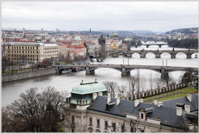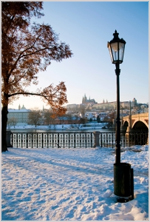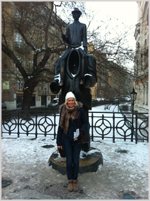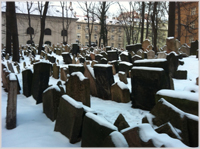 Prague has become one of the top European destinations for a short-break and with good reason. And whilst it might not seem the obvious choice for a mid-winter break, don’t be put off by the cold weather. Simply wandering around the uncrowded fairytale-like city is an winter wonderland experience in itself; and there is plenty to see inside as well as out.
Prague has become one of the top European destinations for a short-break and with good reason. And whilst it might not seem the obvious choice for a mid-winter break, don’t be put off by the cold weather. Simply wandering around the uncrowded fairytale-like city is an winter wonderland experience in itself; and there is plenty to see inside as well as out.
There are many ways to enjoy Prague but my recommendation is to take a more Bohemian approach. Besides being the region within the Czech Republic of which Prague has long been the capital city, the word Bohemian has taken on new meaning. Many people see Bohemia not as a place, but as a state of mind, taking the meaning from the ‘Bohemians’ in 19th century Paris, visiting cafes and watching the bourgeoisie from the Latin Quarter and Montmartre.
So with this in mind, Prague’s famous cafes provided the focus and backdrop to a short-break in this fabulous city. Being January they also provided a welcome refuge from the dry cold and snow which, whilst creating a magical sparkling vista, also are a good excuse for frequent tea and cakes.
These cafes, much like those of Paris in the 19th and early 20th century, were the places where Bohemian writers, philosophers and their patrons dreamed of a new Czechoslovakian nation state, often under very difficult political circumstances. Not recognising many names or faces of the famous authors and artists captured in photographs on the walls didn’t matter; these cafes have a great atmosphere and are perfect for afternoon tea or a morning brunch just chatting or people watching.
With lovely views of the Vlatav and Prague Castle, Cafe Slavia is perhaps the pick of the bunch being situated just across from the National Theatre. This has been a meeting place from the 1920s until the Velvet Revolution in 1989. Restored to its 1930s Art Deco glory, it is set just 500 meters south of The Charles Bridge.
Cafe Louvre is also steeped in history, boasting guests including Karel Capek, Franz Kafka and Albert Einstein during his professorship in Prague. It is also where the Czech arm of the PEN club, an influential literary group was established in 1925. Very pleasant light lunches, indulgent cakes and teas and coffees can be enjoyed overlookong the busy thoroughfare of Národní which runs between Old Town and New Town.
 Where to stay?
Where to stay?
The only choice for a Bohemian break has to be the beautiful Art Nouveau & Art Deco Hotel Paris. This combination of class and luxury within a bohemian city experience is intoxicating. The hotel is ideally situated right next to The Municipal House a stunning Art Nouveau concert hall, cafe and restaurant, built at the height of Czech nationalism and still a major landmark. Besides being a top-class hotel, with every comfort and the highest standards of service, it also boasts an Art Nouveau cafe, the Cafe de Paris, and the lovely Sarah Bernhardt restaurant where sumptuous buffet breakfasts and fine lunch and evening dining can be enjoyed.
Wonderful is an overused word but Prague is truly wonderful. Having been spared fire, ransacking and bombing throughout its turbulent history, it boasts centuries of architectural mastery and splendour. The great attraction about the location of the Hotel Paris is that it is within easy walking distance of every attraction: only a 10 minute walk from Charles Bridge, 5 minutes from Wenceslas Square and in 15 minutes you can walk right across the Old Town.
There are really 5 main areas to visit.
The old city is the medieval settlement of Prague where numerous churches, merchant houses and monuments have been built over the years and where the Old Town Square, St. Nicholas Church, the Astronomical Clock and the Old Town Hall are popular tourist attractions. From the west side, the spectacular Charles Bridge crosses the majestic Vltava River (Moldau in German) linking the old city to the The Lesser Town.
The Lesser Town is the Baroque part of the town that clusters around the foothills of Prague Castle. This is where the film Mozart was located because of its beautiful squares and streets, more reminiscent of Vienna than Vienna itself.
 To understand the city’s more recent history a visit to the Franz Kafka exhibition is recommended. Originally opened in Barcelona in 1999 and after visiting New York, the exhibition was installed permanently in the unique Herget Brickworks] on the Malá Strana [Lesser Town] bank of the river Vltava. (You can see the museum from the Charles Bridge as you cross). Kafka was born a German speaking Jew in 1883 in Prague. The exhibition tells the story of his life at the turn of the century when redevelopment of the Jewish quarter was under way and helps to explain what the city was like but also how it influenced his writing.
To understand the city’s more recent history a visit to the Franz Kafka exhibition is recommended. Originally opened in Barcelona in 1999 and after visiting New York, the exhibition was installed permanently in the unique Herget Brickworks] on the Malá Strana [Lesser Town] bank of the river Vltava. (You can see the museum from the Charles Bridge as you cross). Kafka was born a German speaking Jew in 1883 in Prague. The exhibition tells the story of his life at the turn of the century when redevelopment of the Jewish quarter was under way and helps to explain what the city was like but also how it influenced his writing.
The New Town stands to the east and south of the Old town. Built originally in the 14th and 15th centuries when the city had already out-grown its medieval foundations, this area includes Wenceslas Square, which was originally built as a horse market and now functions as a centre of commerce and tourism. It also includes the 15th century Novom?stská Radnice, or New Town Hall and in general the area, which is quite large, wrapping around the old city as it does, has many areas to explore.
The Josefov, situated just to the north of the Old City and squashed along the banks of the Vltava River, is the Jewish ghetto area of Prague, established as early as the 11th century. With a rich but also terrible history, it plays an important part in understanding how the Germans, Czech and Jews lived together in central Europe and the city over the centuries.
 A visit to the Old Jewish Cemetery is highly recommended as a part of the interesting tour of the Josefov synagogues. According to halakhah, Jews must not destroy Jewish graves or remove tombstones. This meant that when the cemetery ran out of space extra land could not be acquired, that more layers of soil were placed on the existing graves, the old tombstones taken out and placed upon the new layer of soil. This explains why the tombstones in the cemetery are placed so closely to each other, resulting in the cemetery having 12 layers and around 15,000 graves which gives a somewhat chaotic feel.
A visit to the Old Jewish Cemetery is highly recommended as a part of the interesting tour of the Josefov synagogues. According to halakhah, Jews must not destroy Jewish graves or remove tombstones. This meant that when the cemetery ran out of space extra land could not be acquired, that more layers of soil were placed on the existing graves, the old tombstones taken out and placed upon the new layer of soil. This explains why the tombstones in the cemetery are placed so closely to each other, resulting in the cemetery having 12 layers and around 15,000 graves which gives a somewhat chaotic feel.
Prague Castle, or rather the huge castle area, is also situated over the Charles Bridge and which contains not only the castle with its spectacular views over the city and river, but also the cathedral, various galleries, armouries, gardens and other important historical buildings and a small town where the people who lived and worked in the castle resided. One highlight is ‘Little Lane’ where tiny merchant houses have been renovated to see how people lived 300 years ago, as well as the dungeons, full of various instruments of torture.
Getting to and around Prague
Silver Travel Advisor recommends Kirker Holidays for short breaks in Prague all year round. With their selection of the best hotels and an excellent concierge service, you can be assured that every last detail has been taken care of.











